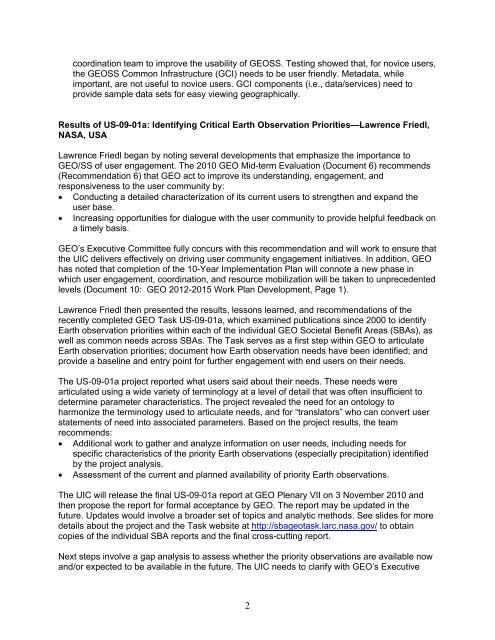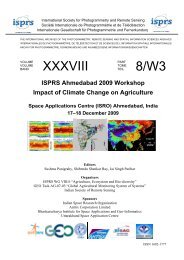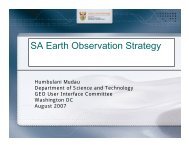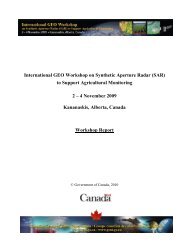GEO UIC Committee: - Group on Earth Observations
GEO UIC Committee: - Group on Earth Observations
GEO UIC Committee: - Group on Earth Observations
Create successful ePaper yourself
Turn your PDF publications into a flip-book with our unique Google optimized e-Paper software.
coordinati<strong>on</strong> team to improve the usability of <str<strong>on</strong>g>GEO</str<strong>on</strong>g>SS. Testing showed that, for novice users,<br />
the <str<strong>on</strong>g>GEO</str<strong>on</strong>g>SS Comm<strong>on</strong> Infrastructure (GCI) needs to be user friendly. Metadata, while<br />
important, are not useful to novice users. GCI comp<strong>on</strong>ents (i.e., data/services) need to<br />
provide sample data sets for easy viewing geographically.<br />
Results of US-09-01a: Identifying Critical <strong>Earth</strong> Observati<strong>on</strong> Priorities—Lawrence Friedl,<br />
NASA, USA<br />
Lawrence Friedl began by noting several developments that emphasize the importance to<br />
<str<strong>on</strong>g>GEO</str<strong>on</strong>g>/SS of user engagement. The 2010 <str<strong>on</strong>g>GEO</str<strong>on</strong>g> Mid-term Evaluati<strong>on</strong> (Document 6) recommends<br />
(Recommendati<strong>on</strong> 6) that <str<strong>on</strong>g>GEO</str<strong>on</strong>g> act to improve its understanding, engagement, and<br />
resp<strong>on</strong>siveness to the user community by:<br />
• C<strong>on</strong>ducting a detailed characterizati<strong>on</strong> of its current users to strengthen and expand the<br />
user base.<br />
• Increasing opportunities for dialogue with the user community to provide helpful feedback <strong>on</strong><br />
a timely basis.<br />
<str<strong>on</strong>g>GEO</str<strong>on</strong>g>’s Executive <str<strong>on</strong>g>Committee</str<strong>on</strong>g> fully c<strong>on</strong>curs with this recommendati<strong>on</strong> and will work to ensure that<br />
the <str<strong>on</strong>g>UIC</str<strong>on</strong>g> delivers effectively <strong>on</strong> driving user community engagement initiatives. In additi<strong>on</strong>, <str<strong>on</strong>g>GEO</str<strong>on</strong>g><br />
has noted that completi<strong>on</strong> of the 10-Year Implementati<strong>on</strong> Plan will c<strong>on</strong>note a new phase in<br />
which user engagement, coordinati<strong>on</strong>, and resource mobilizati<strong>on</strong> will be taken to unprecedented<br />
levels (Document 10: <str<strong>on</strong>g>GEO</str<strong>on</strong>g> 2012-2015 Work Plan Development, Page 1).<br />
Lawrence Friedl then presented the results, less<strong>on</strong>s learned, and recommendati<strong>on</strong>s of the<br />
recently completed <str<strong>on</strong>g>GEO</str<strong>on</strong>g> Task US-09-01a, which examined publicati<strong>on</strong>s since 2000 to identify<br />
<strong>Earth</strong> observati<strong>on</strong> priorities within each of the individual <str<strong>on</strong>g>GEO</str<strong>on</strong>g> Societal Benefit Areas (SBAs), as<br />
well as comm<strong>on</strong> needs across SBAs. The Task serves as a first step within <str<strong>on</strong>g>GEO</str<strong>on</strong>g> to articulate<br />
<strong>Earth</strong> observati<strong>on</strong> priorities; document how <strong>Earth</strong> observati<strong>on</strong> needs have been identified; and<br />
provide a baseline and entry point for further engagement with end users <strong>on</strong> their needs.<br />
The US-09-01a project reported what users said about their needs. These needs were<br />
articulated using a wide variety of terminology at a level of detail that was often insufficient to<br />
determine parameter characteristics. The project revealed the need for an <strong>on</strong>tology to<br />
harm<strong>on</strong>ize the terminology used to articulate needs, and for “translators” who can c<strong>on</strong>vert user<br />
statements of need into associated parameters. Based <strong>on</strong> the project results, the team<br />
recommends:<br />
• Additi<strong>on</strong>al work to gather and analyze informati<strong>on</strong> <strong>on</strong> user needs, including needs for<br />
specific characteristics of the priority <strong>Earth</strong> observati<strong>on</strong>s (especially precipitati<strong>on</strong>) identified<br />
by the project analysis.<br />
• Assessment of the current and planned availability of priority <strong>Earth</strong> observati<strong>on</strong>s.<br />
The <str<strong>on</strong>g>UIC</str<strong>on</strong>g> will release the final US-09-01a report at <str<strong>on</strong>g>GEO</str<strong>on</strong>g> Plenary VII <strong>on</strong> 3 November 2010 and<br />
then propose the report for formal acceptance by <str<strong>on</strong>g>GEO</str<strong>on</strong>g>. The report may be updated in the<br />
future. Updates would involve a broader set of topics and analytic methods. See slides for more<br />
details about the project and the Task website at http://sbageotask.larc.nasa.gov/ to obtain<br />
copies of the individual SBA reports and the final cross-cutting report.<br />
Next steps involve a gap analysis to assess whether the priority observati<strong>on</strong>s are available now<br />
and/or expected to be available in the future. The <str<strong>on</strong>g>UIC</str<strong>on</strong>g> needs to clarify with <str<strong>on</strong>g>GEO</str<strong>on</strong>g>’s Executive<br />
2







